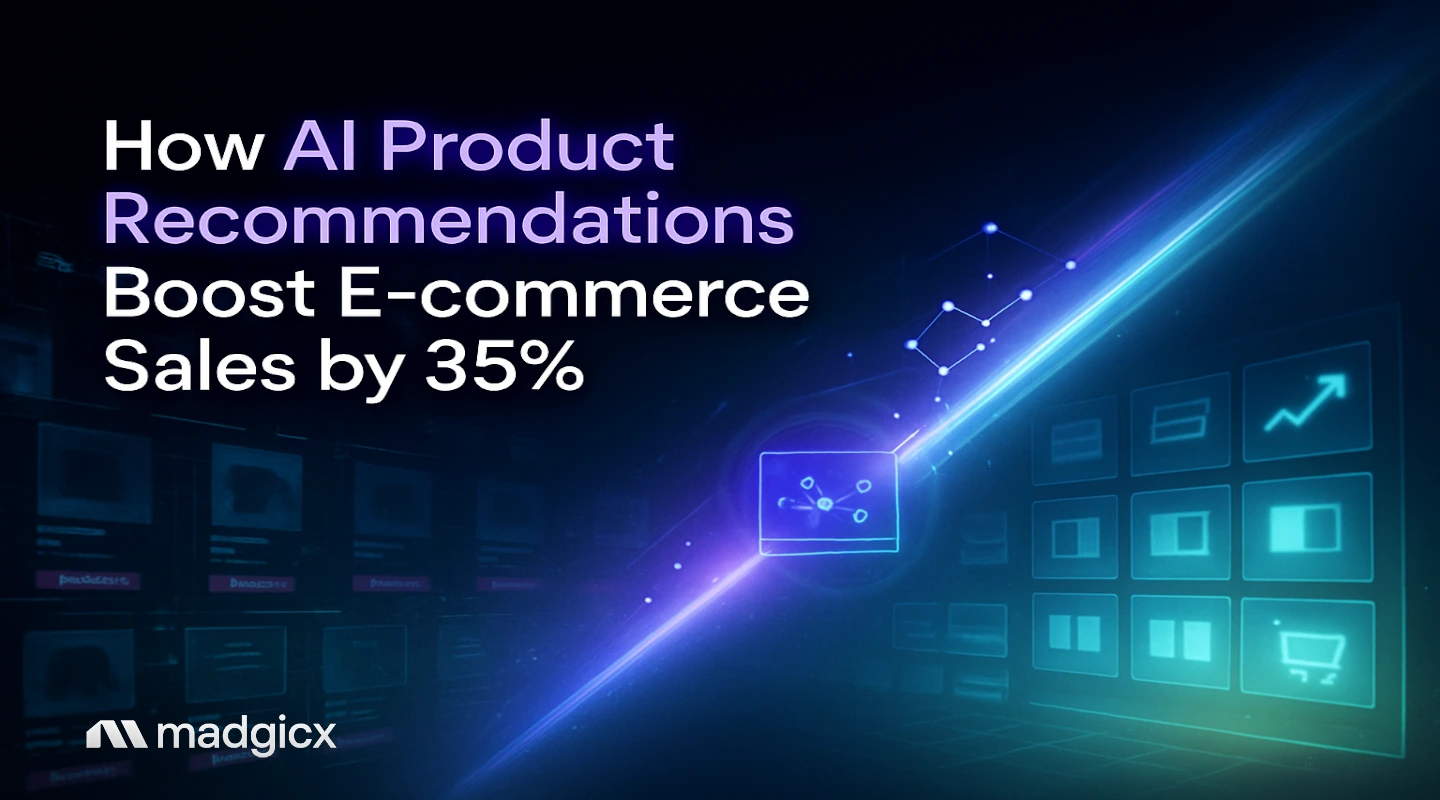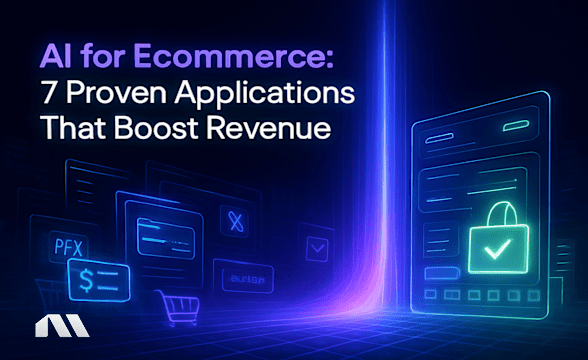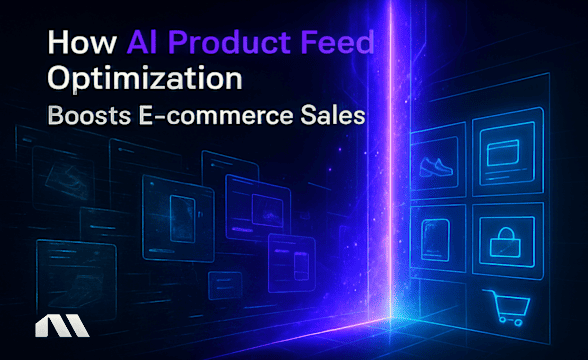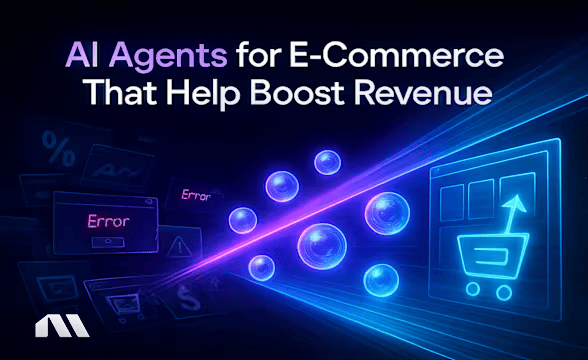Learn how AI product recommendations boost e-commerce sales by 35%. Complete implementation guide with tools, strategies, and ROI optimization techniques.
Picture this: You walk into your favorite coffee shop, and before you even reach the counter, the barista starts preparing your usual order. They know you prefer oat milk on Mondays, add an extra shot when you look tired, and always suggest that blueberry muffin you secretly love but never remember to order.
Now imagine if your online store could do the same thing.
That's exactly what AI product recommendations accomplish for e-commerce businesses. Amazon attributes a whopping 35% of its revenue to its recommendation engine – that's billions of dollars generated simply by showing customers the right products at the right time.
But here's the thing that keeps most e-commerce owners up at night: while you know personalization works, implementing it feels like trying to solve a Rubik's cube blindfolded. You're stuck showing the same generic product grids to everyone, watching potential customers bounce from your site, and wondering why your conversion rates aren't budging despite all your marketing efforts.
Sound familiar? You're not alone.
Most e-commerce businesses are sitting on goldmines of customer data but lack the tools to turn that information into personalized shopping experiences that actually drive sales. The good news? AI has democratized product recommendations.
What once required teams of data scientists and millions in development costs can now be implemented by any e-commerce business – and the results speak for themselves. Companies using AI product recommendations see an average 22.66% increase in conversion rates and significantly higher customer lifetime values.
This guide will walk you through everything you need to know about implementing AI product recommendations for your e-commerce business. We'll cover how the technology works, which tools to use, and most importantly, how to connect your recommendation strategy to your advertising campaigns for maximum ROI.
By the end, you'll have a complete roadmap to transform your generic online store into a personalized shopping destination that customers can't resist.
What You'll Learn
- How AI product recommendations work and why they generate 35% more revenue
- Step-by-step implementation guide for e-commerce platforms
- Integration strategies with Meta advertising for customer journey optimization
- Bonus: ROI measurement framework and optimization techniques
Understanding AI Product Recommendations
What Are AI Product Recommendations?
AI product recommendations use machine learning algorithms to analyze customer behavior, purchase history, and browsing patterns to automatically suggest relevant products that increase sales and improve customer experience.
Think of it as having a super-smart sales assistant who never sleeps, never forgets a customer's preferences, and can serve thousands of shoppers simultaneously. This digital assistant watches how customers interact with your store – what they click, how long they spend on product pages, what they add to cart but don't buy – and uses that information to predict what they're most likely to purchase next.
The magic happens in the algorithms. Unlike traditional rule-based systems that might show "featured products" or "bestsellers" to everyone, AI product recommendations create unique experiences for each visitor.
A fitness enthusiast browsing your athletic wear store will see completely different suggestions than someone shopping for casual weekend clothes, even if they're looking at the same product page.
How AI Recommendation Algorithms Work
There are three main approaches that power modern recommendation systems, and understanding them will help you choose the right strategy for your business.
Collaborative Filtering is the "customers who bought this also bought that" approach. The algorithm identifies patterns across your entire customer base, finding connections between products based on purchasing behavior. If customers frequently buy running shoes and protein powder together, the system learns this association and suggests protein powder to future customers browsing running shoes.
Content-Based Filtering focuses on product attributes and features. Instead of looking at what other customers bought, this method analyzes the characteristics of products a customer has shown interest in. If someone consistently views red dresses in size medium, the algorithm will prioritize showing them other red dresses in size medium.
Hybrid Approaches combine both methods for more accurate recommendations. Netflix famously uses this strategy – their recommendation engine considers both what similar users watched (collaborative) and the genres/actors you prefer (content-based).
This hybrid approach is why 80% of Netflix viewing comes from recommendations rather than search.
Why E-commerce Businesses Need AI Product Recommendations
The numbers don't lie – AI product recommendations are transforming e-commerce. The global recommendation engine market is exploding from $5.39 billion in 2024 to a projected $119.43 billion by 2034, representing a compound annual growth rate of over 35%.
But beyond the impressive market growth, AI product recommendations solve real business problems that every e-commerce owner faces.
First, they dramatically improve conversion rates. When customers see products that actually match their interests and needs, they're much more likely to make a purchase. Studies consistently show that personalized product recommendations can increase conversion rates by an average of 22.66%.
Second, recommendations boost average order value through intelligent cross-selling and upselling. Instead of hoping customers will stumble across complementary products, AI actively suggests items that enhance their primary purchase. A customer buying a camera might see recommendations for memory cards, cases, and lenses – turning a single-item purchase into a complete photography kit.
Third, AI product recommendations improve customer experience and satisfaction. Shoppers spend less time searching for products and more time discovering items they actually want. This enhanced experience leads to higher customer lifetime value and increased brand loyalty.
Pro Tip: For businesses implementing AI strategies for DTC brands, product recommendations serve as the foundation for broader personalization efforts that extend into email marketing, advertising campaigns, and customer service.
Types of AI Recommendation Systems for E-commerce
Product-to-Product Recommendations
The "customers who viewed this also viewed" recommendation is probably the most familiar type you'll encounter. This system analyzes product relationships based on browsing and purchasing patterns, creating connections between items that customers frequently view or buy together.
Implementation is straightforward but powerful. When a customer views a specific product, the algorithm instantly calculates which other products have the strongest associations and displays them prominently.
Amazon perfected this approach – their "frequently bought together" section often includes items customers didn't even know they needed but end up purchasing anyway.
The key to success with product-to-product recommendations is placement and timing. Display these suggestions on product pages, in shopping carts, and during checkout. Many businesses see significant improvements by showing related products immediately after a customer adds an item to their cart, capitalizing on their buying momentum.
User-Based Personalization
"Recommended for you" sections take personalization to the next level by creating unique product suggestions for each individual customer. These systems build detailed profiles based on browsing history, purchase patterns, demographic information, and even time-based behaviors.
The algorithm considers factors like:
- Seasonal preferences
- Brand loyalty patterns
- Price sensitivity
- Category interests
A customer who consistently shops for premium organic products will see different recommendations than someone who primarily purchases budget-friendly options, even when browsing the same category.
User-based personalization works particularly well for returning customers, where you have sufficient behavioral data. For new visitors, the system can use demographic information, geographic location, and real-time browsing behavior to make educated guesses about preferences.
Cross-Selling and Upselling Systems
These recommendation engines focus specifically on increasing order value by suggesting complementary products (cross-selling) or premium alternatives (upselling). The algorithms analyze purchase patterns to identify which products are frequently bought together or which upgrades customers typically choose.
Cross-selling recommendations might suggest phone cases and screen protectors to someone buying a smartphone, while upselling could recommend a higher-capacity model or extended warranty. The timing of these suggestions is crucial – they're most effective when presented during the shopping journey rather than after purchase completion.
Smart cross-selling systems also consider inventory levels and profit margins, prioritizing suggestions that benefit both the customer and your business. This approach is particularly valuable for businesses looking to reduce cart abandonment by making the checkout process feel more complete and valuable.
Real-Time Dynamic Recommendations
The most sophisticated recommendation systems adapt in real-time based on current browsing behavior and external factors like inventory levels, seasonal trends, and promotional campaigns. These dynamic systems can adjust suggestions within seconds of customer actions.
For example, if a customer spends significant time viewing winter coats but hasn't made a purchase, the system might start showing complementary winter accessories or limited-time discounts on coats. If inventory is running low on a popular item, the algorithm can prioritize showing it to customers most likely to purchase.
Real-time recommendations also consider session context – what the customer has viewed in their current visit, how much time they're spending on different pages, and whether they've shown signs of purchase intent or exit behavior. This immediate responsiveness creates more engaging shopping experiences and captures sales that might otherwise be lost.
Implementation Guide for E-commerce Platforms
Data Collection and Preparation
Before diving into AI product recommendations, you need to establish a solid data foundation. The quality of your recommendations depends entirely on the quality of your data, so this step is crucial for success.
Start with comprehensive behavior tracking. Implement analytics that capture every meaningful interaction on your site:
- Page views and time spent
- Product interactions
- Cart additions and removals
- Purchase completions
- Exit behaviors
Don't forget about negative signals like cart abandonments or quick exits from product pages, as these help the algorithm understand what customers don't want.
Product catalog optimization is equally important. Ensure every product has detailed, consistent attributes including categories, subcategories, brands, colors, sizes, prices, and descriptions. The more structured data you provide, the better your content-based filtering will perform.
Consider adding tags for seasonal items, trending products, or special collections.
Privacy compliance cannot be an afterthought. With GDPR, CCPA, and other privacy regulations, you must implement proper consent mechanisms and data handling procedures. Be transparent about data collection and give customers control over their personalization preferences.
Many businesses find that customers willingly share data when they understand the value they'll receive in return.
Platform-Specific Implementation
Shopify Integration offers the most straightforward path for most e-commerce businesses. Shopify's ecosystem includes numerous AI recommendation apps that integrate seamlessly with your existing store. Popular options include:
- Bold Product Upsell
- ReConvert
- Native Shopify recommendations
The implementation process typically involves installing an app, configuring recommendation types and placements, and customizing the visual design to match your brand. Most Shopify recommendation apps provide analytics dashboards showing performance metrics and revenue attribution.
WooCommerce Setup requires more technical knowledge but offers greater customization flexibility. You can choose from plugins like:
- YITH WooCommerce Frequently Bought Together
- WooCommerce Product Recommendations
- Custom API integrations
For businesses with custom e-commerce solutions, consider cloud-based recommendation services like Amazon Personalize, Google AI recommendations, or specialized e-commerce platforms that offer API integration. These services handle the complex machine learning while you focus on implementation and optimization.
Integration with Advertising Platforms
Here's where most businesses miss a huge opportunity – connecting recommendation data to advertising campaigns. Your on-site recommendation insights reveal incredibly valuable information about customer preferences and purchase intent that can supercharge your Meta advertising performance.
Start by implementing the Meta Pixel with enhanced e-commerce tracking. This allows you to send detailed product interaction data back to Facebook, including which recommended products customers viewed, added to cart, or purchased. This data helps Meta's algorithm optimize your campaigns for customers most likely to engage with your products.
Create custom audiences based on recommendation interactions:
- Customers who viewed recommended products but didn't purchase
- Users who frequently purchase recommended items
- Lookalike audiences based on high-engagement customers
Pro Tip: Connect recommendation data to Meta advertising audiences for 40% better ad performance. Customers who engage with personalized recommendations show higher intent and convert at significantly better rates when retargeted through paid advertising.
For businesses implementing comprehensive AI advertising strategies for local businesses, this integration creates a powerful feedback loop where on-site personalization informs advertising targeting, and advertising data enhances recommendation accuracy.
Best AI Recommendation Tools and Platforms
Enterprise Solutions
Amazon Personalize stands as the gold standard for large enterprises with complex requirements and substantial budgets. This machine learning service provides the same recommendation technology that powers Amazon's own e-commerce platform, offering unparalleled sophistication and scalability.
Amazon Personalize excels in handling massive datasets and complex customer journeys. It can process millions of interactions and provide real-time recommendations with minimal latency. The platform offers multiple algorithm types including user personalization, similar items, and personalized ranking.
However, Amazon Personalize requires significant technical expertise and substantial data volumes to perform optimally. Implementation typically involves data scientists and can take months to fully deploy. Pricing is based on data processing and inference requests, making it expensive for smaller businesses.
Google AI Recommendations provides another enterprise-grade option with strong integration into Google's advertising ecosystem. The platform leverages Google's machine learning expertise and can connect recommendation data to Google Ads campaigns for enhanced targeting and optimization.
E-commerce Platform Solutions
Madgicx occupies a distinct position as a Meta advertising optimization platform designed specifically for e-commerce. While recommendation engines personalize the on-site experience, Madgicx optimizes the advertising that drives qualified traffic to those personalized experiences. The platform's AI Marketer continuously monitors your Meta advertising campaigns (Facebook/Instagram) to:
- Prevent wasted ad spend on low-quality traffic
- Identify audiences most likely to engage with your products
- Scale campaigns that drive customers to your site
- Optimize budget allocation across campaigns 24/7
Try Madgicx’s AI for free here.
Nosto and Dynamic Yield represent traditional e-commerce personalization platforms with strong recommendation capabilities. These solutions offer comprehensive personalization beyond just product recommendations, including:
- Content personalization
- Email marketing integration
- A/B testing frameworks
Both platforms provide good performance for mid-market businesses but lack the deep advertising integration that makes Madgicx unique. They're solid choices for businesses primarily focused on on-site personalization without extensive paid advertising needs.
Budget-Friendly Options for Small Businesses
Shopify Native Tools provide basic recommendation functionality for businesses just starting with personalization. Shopify's built-in "Related products" and "You may also like" features use simple collaborative filtering to suggest products based on customer behavior patterns.
While not as sophisticated as dedicated AI platforms, Shopify's native recommendations are free, easy to implement, and can provide meaningful improvements for smaller stores. They work particularly well for businesses with focused product catalogs and clear customer segments.
WordPress Plugins offer affordable options for WooCommerce stores. Plugins like "Frequently Bought Together" and "Product Recommendations" provide basic recommendation functionality at low monthly costs. These solutions work well for businesses with limited budgets who want to test recommendation effectiveness before investing in more sophisticated platforms.
For businesses in specific verticals like AI fashion ads, specialized plugins can provide industry-specific recommendation logic that performs better than generic solutions.
Measuring ROI and Optimization Strategies
Key Performance Metrics
Measuring the success of your AI product recommendations system requires tracking specific metrics that directly correlate to business value. Revenue attribution stands as the most important metric – you need to know exactly how much additional revenue your recommendations generate compared to generic product displays.
Track these essential metrics:
- Recommendation click-through rates
- Conversion rates for recommended vs. non-recommended products
- Average order values for customers engaging with recommendations
- Customer lifetime value impact over time
Most businesses see 15-30% higher conversion rates and 20-40% higher average order values from customers who engage with personalized recommendations.
Customer lifetime value impact often provides the most compelling long-term ROI story. Customers who regularly purchase recommended products typically show higher engagement, increased purchase frequency, and stronger brand loyalty. Track cohort analysis comparing customers who engage with recommendations versus those who don't to quantify this long-term value.
Don't forget to measure recommendation coverage and diversity. Coverage indicates what percentage of your product catalog gets recommended, while diversity measures how varied the recommendations are. High coverage ensures you're maximizing sales opportunities across your entire inventory, while appropriate diversity prevents recommendations from becoming repetitive or boring.
A/B Testing Frameworks
Systematic A/B testing is crucial for optimizing recommendation performance. Start with testing different algorithm approaches – compare collaborative filtering versus content-based filtering versus hybrid approaches to determine what works best for your specific customer base and product catalog.
Test recommendation placement and timing extensively:
- Product pages vs. category pages vs. cart pages
- Number of recommendations displayed (3-4 vs. 8-10 options)
- Timing within the customer journey
Visual design and messaging significantly impact recommendation performance. Test different layouts, product image sizes, and call-to-action text. Some businesses find that framing recommendations as "Customers like you also bought" performs better than generic "Related products" headers.
Advanced Optimization Techniques
Seasonal adjustments can dramatically improve recommendation relevance and performance. Implement logic that considers seasonal trends, holidays, and promotional periods when generating suggestions. A customer browsing summer clothes in March might be planning ahead, while the same behavior in August indicates immediate purchase intent.
Inventory-based recommendations help optimize both customer experience and business operations. Prioritize recommending products with healthy inventory levels while gradually reducing recommendations for items approaching stockouts. This approach prevents customer disappointment while helping manage inventory turnover.
Cross-platform customer journey optimization represents the most advanced recommendation strategy. Connect recommendation data with:
- Email marketing campaigns
- Retargeting ads
- Customer service interactions
This holistic approach often delivers the highest ROI but requires sophisticated data integration and campaign management capabilities.
Pro Tip: For businesses looking to optimize their entire product catalog, implementing Meta product catalog optimization alongside recommendation systems creates powerful synergies that improve both organic discovery and paid advertising performance.
Future Trends and Advanced Applications
2025 Trends in AI Product Recommendations
Privacy-preserving techniques are reshaping how recommendation systems collect and process customer data. With increasing privacy regulations and consumer awareness, businesses are adopting federated learning and differential privacy methods that provide personalization without compromising individual privacy.
These approaches allow recommendation algorithms to learn from customer behavior patterns without storing or accessing personal data directly. The technology is becoming more accessible to smaller businesses through cloud-based services that handle the complex privacy-preserving computations.
Real-time personalization advances are making recommendations more responsive and contextual. Modern systems can adjust suggestions based on:
- Current browsing session behavior
- External factors like weather or local events
- Real-time inventory levels
- Social media trends
This immediate responsiveness creates more engaging shopping experiences and captures sales opportunities that traditional batch-processing systems might miss.
Voice and visual search integration is expanding recommendation capabilities beyond traditional text-based interactions. Customers can now receive product suggestions through voice assistants or by uploading images of desired items. These new interaction methods require recommendation systems to understand and process different types of input data while maintaining personalization accuracy.
Integration with Emerging Technologies
AR/VR shopping experiences are creating new opportunities for immersive product recommendations. Virtual showrooms can suggest complementary products in realistic settings, allowing customers to visualize complete looks or room designs. These technologies are particularly powerful for fashion, furniture, and home decor businesses.
IoT device recommendations represent an emerging frontier where connected devices can automatically suggest products based on usage patterns and needs. Smart home systems might recommend replacement filters or energy-efficient upgrades, while fitness trackers could suggest nutritional supplements or workout equipment.
Predictive analytics evolution is moving beyond reactive recommendations toward proactive suggestions that anticipate customer needs before they're explicitly expressed. These systems analyze patterns in customer behavior, seasonal trends, and external data sources to predict future purchase intent and suggest products accordingly.
Frequently Asked Questions
How much do AI product recommendations cost for small businesses?
Costs vary significantly based on your platform and requirements. Shopify apps typically range from $10-50 per month for basic functionality, while dedicated platforms like Nosto or Dynamic Yield can cost $500-2000+ monthly. Enterprise solutions like Amazon Personalize use usage-based pricing that can reach thousands monthly for high-traffic sites.
Many businesses start with platform-native tools or budget-friendly apps to test effectiveness before investing in more sophisticated solutions.
What data do I need to start using AI product recommendations?
At minimum, you need product catalog data (names, categories, prices) and basic customer interaction data (page views, purchases). More data improves performance – browsing behavior, time spent on pages, cart additions, customer demographics, and purchase history all enhance recommendation accuracy.
Most systems can start providing basic recommendations with just a few weeks of interaction data, though performance improves significantly with 3-6 months of historical data.
How long does it take to see ROI from AI product recommendations?
Most businesses see initial improvements within 2-4 weeks of implementation, with full ROI typically achieved within 3-6 months. The timeline depends on your traffic volume, product catalog size, and recommendation system sophistication.
Higher-traffic sites with diverse product catalogs usually see faster results since the algorithms have more data to learn from. Start with simple implementations and gradually add complexity as you gather performance data.
Can AI product recommendations work with my existing advertising campaigns?
Absolutely, and this integration often provides the highest ROI. Recommendation data reveals valuable customer preferences that can enhance advertising targeting and creative strategies. You can create custom audiences based on recommendation interactions, use product affinity data for dynamic ads, and optimize campaigns based on on-site personalization performance.
Platforms like Madgicx specialize in connecting recommendation insights to advertising optimization for maximum effectiveness.
What's the difference between rule-based and AI-powered recommendations?
Rule-based systems use predetermined logic like "show bestsellers" or "display products from the same category." They're simple to implement but provide the same suggestions to all customers.
AI-powered recommendations use machine learning to analyze customer behavior patterns and create personalized suggestions for each individual. While AI systems require more setup and data, they typically deliver 2-3x better performance through true personalization rather than generic rules.
Start Implementing AI Product Recommendations Today
The evidence is overwhelming – AI product recommendations can increase your e-commerce revenue by 35%, boost conversion rates by over 22%, and create the personalized shopping experiences that modern customers expect. But here's the key insight that separates successful implementations from disappointing ones: start simple and evolve strategically.
You don't need to build Amazon's recommendation engine on day one. Begin with basic collaborative filtering using your platform's native tools or affordable apps. Focus on getting clean data collection in place and testing different recommendation placements. Once you're seeing positive results, gradually add more sophisticated features like real-time personalization and cross-platform integration.
The biggest opportunity lies in connecting your recommendation insights to your advertising campaigns. Most businesses treat on-site personalization and paid advertising as separate activities, missing the powerful synergies between them. When you integrate recommendation data with your Meta advertising campaigns with platforms like Madgicx, you create a complete customer journey optimization system that maximizes ROI at every touchpoint.
Remember, AI product recommendations aren't just about showing related products – they're about understanding your customers deeply enough to anticipate their needs and guide them toward purchases they'll love. This customer-centric approach builds loyalty, increases lifetime value, and creates sustainable competitive advantages that generic product displays simply can't match.
The e-commerce landscape is evolving rapidly, and businesses that embrace AI personalization now will have significant advantages over those who wait. Your customers are already experiencing sophisticated recommendations on Amazon, Netflix, and other platforms – they expect the same level of personalization from your store.
Start your AI product recommendations journey today, measure everything, and continuously optimize based on real performance data. The technology has never been more accessible, and the potential returns have never been higher.
Transform your product recommendations and Meta advertising performance with Madgicx's AI-driven platform. Our integrated approach optimizes both your on-site personalization and Meta advertising campaigns for maximum ROI.
Digital copywriter with a passion for sculpting words that resonate in a digital age.







.avif)







